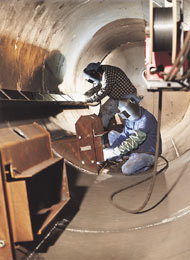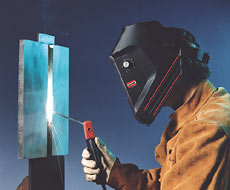Understanding the AWS Certificate
The American Welding Society (AWS) publishes specifications for a wide variety of welding filler metals. These specifications are a series of rules and standards used by the welding industry to classify welding electrodes.
The A5 group of specifications provides requirements for:
Electrode classification including mechanical properties and the composition of the weld metal or the filler metal itself
Electrode sizes and identification
Manufacturer's identification and packaging
This article concentrates on the electrode classification certificate, what it means and how it is used. This certificate is sometimes referred to as a typical cert, AWS certificate or certificate of conformance. First we must clarify how an electrode is classified. Our focus for this article is on carbon and low alloy steel electrodes, as these are the types of metals most frequently welded.
When the manufacturer attaches the AWS specification and classification to the electrode package or places the classification on the product, the manufacturer is certifying that the product meets the requirements of that classification. This method of identification allows the welder to ensure that the proper electrode is being used for the metal to be welded. To make this designation, the manufacturer must conduct the testing specified, since AWS does not perform any testing of its own. The results that are reported on the AWS typical certificate are from the welding test(s) and the laboratory analysis, which are completed under a uniform set of conditions and to a rigid set of standards laid out in the specification that covers this particular consumable group (e.g. AWS A5.1 Specification for Carbon Steel Electrodes for Shielded Metal Arc Welding).
A certification document is not required by the AWS A5 specification but it is the most convenient way to provide proof of classification to the public. When the electrode manufacturer provides the classification for their products and displays it along with the AWS specification on the package, they are certifying it meets all of the specification requirements.
Classification provides a standard for identifying welding consumables, their minimum tensile strength and usability. A complete explanation of each portion of the classification is shown in the side bar, "Typical Electrode Classification." This is a Shielded Metal Arc Welding (SMAW) electrode often referred to as "stick electrode" that is classified in the A5.1 standard.
Typical Electrode Classification
This example is for "low hydrogen", potassium-bearing iron powder electrode suitable for welding mild steel with both AC and DC electrode positive current. Using a similar system, other shielded metal arc electrodes, solid and cored welding wires, submerged arc flux/wire combinations and other types of welding consumables are also classified.
|
E |
70 |
1 |
8 |
|
Electrode |
Tensile Strength |
Position |
Flux Coating and Current |
- The "E" designates that this is an electrode as opposed to a rod or flux
- The "70" describes the minimum tensile strength as 70 ksi, in this case, stated in US customary units. If this designation had been in metric SI units, the classification would be E4918
- The next digit indicates the general usability of the electrode classification. The "1" identifies that this electrode can be used for welding in all positions
- Lastly the "8" signifies the type of flux coating and current type/polarity applicable
A properly prepared certificate of conformance lists the requirements for the electrode classification and the test results for the diameter(s) required. A certificate reports the outcome of the tests performed using representative or typical material for the product being classified. The certificate does not provide specific results from a particular manufacturing run, batch or lot of product. AWS electrode specifications are designed to classify electrodes. Representative materials for the sizes stipulated by the given specification are tested as a method of determining the electrode characteristics, not how a particular batch of product performed against a set of standards; this more specific type of testing could be a definition of "lot testing". The specification dictates the minimum tensile strength, yield strength, the percent of elongation, Charpy impact energy and weld deposit analysis using a specified electrode size, welding procedure and weld joint configuration. The result of this testing is the necessary evidence that the product meets the stated classification. In short, not every size of every product is tested and the test results do not need to be published on the certificate for these other sizes. These other sizes can be classified providing the electrode that has been tested meets the specification requirements.
Certificates of conformance do not actually expire. A certificate is valid conformation of classification for the life of the electrode that is manufactured during its validation period. As an example: on April 15, 2004 the testing for the typical certificate of conformance for product "A" was completed and the test completion date of April 15, 2004 is shown on this certificate. On April 30, 2004 a production run of the 1/8-inch size of product "A" is manufactured. Another certificate for product "A" was completed on April 1, 2005. On May 3, 2005 a distributor sells a package of the 1/8-inch size of product "A" manufactured on April 30, 2004, even though the April 1, 2005 certificate was recently published. The proper certificate for this product is the one with the test completion date of April 15, 2004. A certificate is good for the material manufactured from the test completion date forward until such time as the required testing is performed again.
Fabrication or construction specifications and other governing bodies may dictate the frequency that the classification needs to be reconfirmed. However, AWS does not stipulate a retest frequency. Depending on what other specifications are in use and what type of structure the welding consumable is intended for use on will dictate the length of time a certificate is valid, but a certificate of conformance does not expire.
An AWS typical certificate is used as proof that the electrode of a given classification meets the minimum requirements for that class. The fabricator can include the certificates for the consumables used for a weldment as part of the documentation of proper construction. This is a construction code requirement for steel bridge fabricators. State and Federal highway construction codes or contracts require, as a minimum, a certificate of conformance for each welding product used. For some projects, a certificate showing the actual results of testing for a controlled lot of a specific size of a product may be required. Having documented proof that an electrode meets the stipulated specification requirements is the primary use of certificates of conformance.
Frequently Asked Questions
Q: Are electrode sizes other than those tested classified and covered by that product's typical certificate?
A: Yes, if the diameter(s) required to be tested by the AWS specification have passed the required testing then all sizes of that product are classified and
the AWS certificate applies.
Q: Is a certificate of conformance document required for classified products?
A: The AWS filler metal specifications do not require a certificate. However, it is a convenient way to document compliance.
Q: Do AWS certificates expire?
A: No, a certificate never expires for the electrode that was manufactured during its validation period regardless if the electrode is not used for 1 year, 3
years or longer.
Q: Does the electrode classification certificate provide data for a specific production run of electrode?
A: No, the results shown on the certificate are "typical" results that are representative of the manufactured product for a given classification. Testing was
not necessarily conducted on samples of the specific material shipped.
Q: Does an AWS typical certificate satisfy the American Society of Mechanical Engineers (ASME) SFA requirements?
A: Yes, a certificate of conformance referencing the appropriate SFA specification and showing the product's AWS classification provides the necessary
classification documentation for the corresponding ASME SFA.




